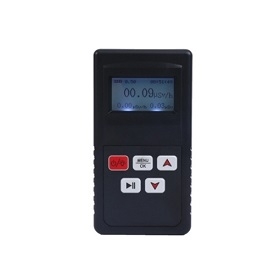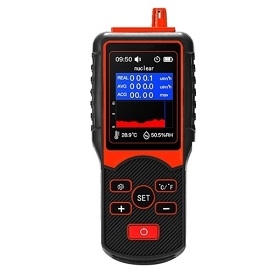A nuclear radiation detector is a specialized device designed to detect and measure the presence of ionizing radiation in its surroundings. Ionizing radiation includes alpha particles, beta particles, gamma rays, and X-rays, all of which have enough energy to remove tightly bound electrons from atoms, creating charged particles (ions). Using a nuclear radiation detector properly is essential to ensure accurate measurements and, more importantly, to maintain safety. sisco store gives you an overview of the proper way to use a nuclear radiation detector.
Operating Principle
Nuclear radiation detectors are devices for detecting radiation rays. Commonly used are ionization chambers, counting tubes and scintillation counters, atomic nucleus emulsions, solid nucleus trace detectors, and semiconductor detectors. These detectors measure radiation rays and their properties. The principle is mainly the use of rays and material interaction produced by a variety of effects. Such as the application of charged particles and substances produced by the principle of ionization of the production of ionization chambers, counting tubes, as well as alpha track detectors; the use of its fluorescence made of scintillation counters; the use of ionization and excitation caused by the chemical reaction process to produce atomic nuclei emulsion, solid nuclear track detectors. Charged ions can be directly applied to the above properties, for uncharged particles (such as γ-rays), the application of its role with the material of the three effects (photoelectric effect, Compton-Wu Youxun effect, the effect of electron pairs) produced by the secondary electrons to achieve the above purposes.
Usage Steps
Using a nuclear radiation detector properly is essential to ensure accurate measurements and, more importantly, to maintain safety. The specific steps for using a nuclear radiation detector can vary depending on the type of detector and its manufacturer. However, the following general guidelines apply to many common radiation detectors.
- Read the User Manual
Start by reading the user manual or operating instructions provided by the manufacturer. Each type and model of radiation detector may have unique features and usage instructions. - Prepare the Environment
Ensure that you are in a location free from interference that could affect the detector's readings.
Make sure the detector is calibrated and in good working condition. Calibration should be done at regular intervals as per the manufacturer's recommendations. - Turn On the Detector
Power on the radiation detector using the provided switch or button. Some detectors may have a warm-up period, so allow it to stabilize before taking measurements. - Select the Appropriate Mode
If your d etector has multiple modes (e.g., count rate, dose rate, energy spectrum), select the mode that best suits your application.
etector has multiple modes (e.g., count rate, dose rate, energy spectrum), select the mode that best suits your application. - Set Measurement UnitsChoose the desired measurement units, such as counts per minute (CPM), microsieverts per hour (µSv/h), or other relevant units based on your needs.
- Stabilize the Detector
Let the detector stabilize for a few moments before taking measurements, especially if it has a warm-up period.
Hold the detector steady and at a consistent distance from the radiation source. - Take Measurements
Point the detector toward the radiation source or the area you want to measure.
Maintain a constant speed and distance from the source. Record the readings or observations as necessary. - Interpret and Record DataUnderstand the detector's display and the units of measurement.
Record the measurements along with relevant information such as date, time, location, and any specific conditions. - Assess Alarm and Thresholds
Be aware of any alarm thresholds or limits set on the detector. If radiation levels exceed these limits, the detector may sound an alarm or provide visual warnings. - Maintain Safety Precautions
Always use appropriate personal protective equipment if necessary, especially in situations with potentially harmful levels of radiation.
Keep a safe distance from radiation sources and follow safety guidelines and regulations. - Data Logging (If Applicable)
If the detector has data logging capabilities, you can record measurements over time for trend analysis and documentation. - Power Off the Detector
When you have completed your measurements, power off the detector to conserve battery life and prevent accidental operation. - Store and Maintain the Detector
Store the radiation detector in a safe and appropriate location, following the manufacturer's recommendations for maintenance and calibration.
Notes on Use

Training and Education: Ensure that users are properly trained in radiation safety and are knowledgeable about the specific type of radiation detector they are using. Training should cover the principles of radiation, instrument operation, safety protocols, and emergency procedures.
Personal Protective Equipment (PPE): Depending on the radiation levels and the specific application, users may need to wear appropriate PPE, such as lab coats, gloves, safety glasses, and even lead aprons. Use PPE as recommended by safety guidelines and risk assessments.
Pre-Use Inspection: Before each use, inspect the detector for physical damage, such as cracks or loose components. Ensure that the detector is in good working condition and properly calibrated.
Calibration: Calibrate the detector as per the manufacturer's instructions and recommended intervals to maintain accurate measurements. Regular calibration is essential to ensure the reliability of the instrument.
Safe Distance: Maintain a safe distance from radiation sources whenever possible. Minimize close contact with potentially radioactive materials. Keep in mind the inverse square law, which states that radiation exposure decreases with the square of the distance from the source.
Shielding: Use shielding materials or barriers, such as lead or plastic shields, to reduce exposure to radiation when necessary. Be aware of the shielding's effectiveness and any potential scatter radiation.
Proper Handling: Handle radioactive sources with care, using appropriate tools, containers, and shielding as required. Minimize direct contact with radioactive materials.
Minimize Exposure Time: Minimize the time spent near radiation sources. Quick, efficient measurements reduce the risk of radiation exposure.
Avoid Ingestion and Inhalation: Prevent ingestion or inhalation of radioactive materials. Ensure proper containment and ventilation in environments where radioactive substances are used.
Environmental Control: Use radiation detectors in controlled environments and ensure that background radiation levels are well-documented. Avoid conducting measurements in areas with high background radiation or interference.
Emergency Procedures: Be familiar with emergency procedures in case of unexpected events, such as alarm activation, equipment malfunction, or accidents involving radioactive materials. Know how to respond and who to contact.
Data Recording: Accurately document measurements, including the date, time, location, and any relevant conditions. Keep records for regulatory compliance and future reference.
Regular Maintenance: Follow the manufacturer's recommendations for maintenance and regular inspection of the detector. Ensure that the detector remains in optimal working condition.
By following the proper usage steps, the use of nuclear radiation detectors can be conducted effectively and without undue risk to personnel and the environment. Always consult with radiation safety officers and experts in your organization to ensure compliance with specific safety protocols and regulatory requirements. If you are in need of a nuclear radiation detector, we can provide you with quality products such as handheld nuclear radiation detector, nuclear radiation detector with geiger counter. Please feel free to call us!

